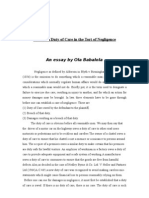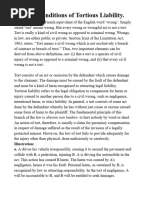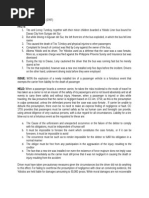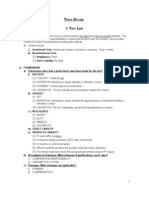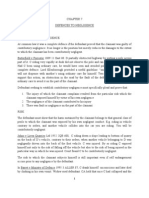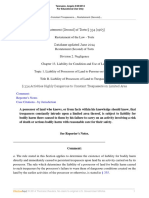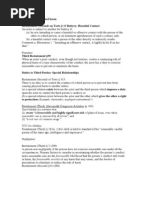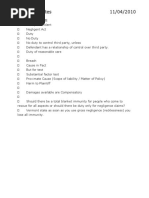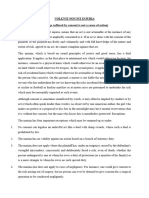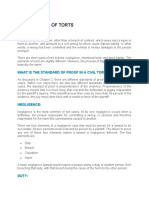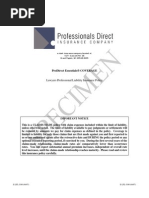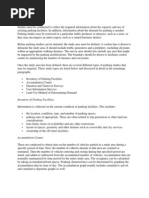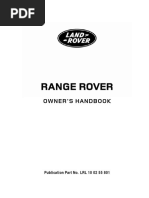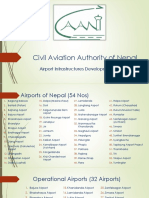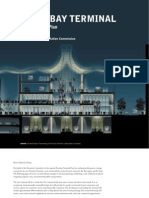Restate 2d Superseding Cause Excerpts
Restate 2d Superseding Cause Excerpts
Uploaded by
George ConkCopyright:
Available Formats
Restate 2d Superseding Cause Excerpts
Restate 2d Superseding Cause Excerpts
Uploaded by
George ConkOriginal Title
Copyright
Available Formats
Share this document
Did you find this document useful?
Is this content inappropriate?
Copyright:
Available Formats
Restate 2d Superseding Cause Excerpts
Restate 2d Superseding Cause Excerpts
Uploaded by
George ConkCopyright:
Available Formats
440 Superseding Cause Defined A superseding cause is an act of a third person or other force which by its intervention prevents
the actor from being liable for harm to another which his antecedent negligence is a substantial factor in bringing about. COMMENTS & ILLUSTRATIONS: Comment: a. An intervening cause is defined in 441. The rules which determine whether an intervening force is a superseding cause are stated in 442-453 and Comments thereto. b. A superseding cause relieves the actor from liability, irrespective of whether his antecedent negligence was or was not a substantial factor in bringing about the harm. Therefore, if in looking back from the harm and tracing the sequence of events by which it was produced, it is found that a superseding cause has operated, there is no need of determining whether the actor's antecedent conduct was or was not a substantial factor in bringing about the harm.
441 Intervening Force Defined (1) An intervening force is one which actively operates in producing harm to another after the actor's negligent act or omission has been committed. (2) Whether the active operation of an intervening force prevents the actor's antecedent negligence from being a legal cause in bringing about harm to another is determined by the rules stated in 442-453.
442 Considerations Important in Determining Whether an Intervening Force Is a Superseding Cause The following considerations are of importance in determining whether an intervening force is a superseding cause of harm to another: (a) the fact that its intervention brings about harm different in kind from that which would otherwise have resulted from the actor's negligence; (b) the fact that its operation or the consequences thereof appear after the event to be extraordinary rather than normal in view of the circumstances existing at the time of its operation; (c) the fact that the intervening force is operating independently of any situation created by the actor's negligence, or, on the other hand, is or is not a normal result of such a situation; (d) the fact that the operation of the intervening force is due to a third person's act or to his failure to act; (e) the fact that the intervening force is due to an act of a third person which is wrongful toward the other and as such subjects the third person to liability to him; (f) the degree of culpability of a wrongful act of a third person which sets the intervening force in motion. Comment on Clause (c): d. The words "situation created by the actor's negligence" are used to denote the fact that the actor's negligent conduct is a substantial factor in bringing about the situation and that, therefore, the actor would be liable for creating the situation if the situation were in itself a legal injury.
442A Intervening Force Risked by Actor's Conduct Where the negligent conduct of the actor creates or increases the foreseeable risk of harm through the intervention of another force, and is a substantial factor in causing the harm, such intervention is not a superseding cause. COMMENTS & ILLUSTRATIONS: Comment: a. The rule stated in this Section applies to any intervening force, whether it be a force of nature, or the act of a human being, or of an animal. b. Where the negligence of the actor has created the risk of harm to another because of the likelihood of such intervention, the actor is not relieved of responsibility merely because the risk which he has created has in fact been fulfilled. The same is true where there is already some existing risk or possibility of the intervention, but the negligence of the actor has increased the risk of such intervention, or of harm if it occurs. Illustration: 1. In the month of December A voluntarily ships potatoes in an unheated car of B Railroad through the state of New York. B Railroad negligently delays the shipment for three days, thereby increasing the already existing risk that the potatoes will be damaged by cold. During the extra three days severe cold weather sets in, and damages the potatoes. B Railroad is subject to liability to A.
442B Intervening Force Causing Same Harm as That Risked by Actor's Conduct Where the negligent conduct of the actor creates or increases the risk of a particular harm and is a substantial factor in causing that harm, the fact that the harm is brought about through the intervention of another force does not relieve the actor of liability, except where the harm is intentionally caused by a third person and is not within the scope of the risk created by the actor's conduct. COMMENTS & ILLUSTRATIONS: Comment: a. The rule stated in this Section is a special application of the principle stated in 435 (1), that the fact that the actor neither foresaw nor could have foreseen the manner in which a particular harm is brought about does not prevent his liability where the other conditions necessary to it exist. Compare Illustration 1 under that Section. b. If the actor's conduct has created or increased the risk that a particular harm to the plaintiff will occur, and has been a substantial factor in causing that harm, it is immaterial to the actor's liability that the harm is brought about in a manner which no one in his position could possibly have been expected to foresee or anticipate. This is true not only where the result is produced by the direct operation of the actor's conduct upon conditions or circumstances existing at the time, but also where it is brought about through the intervention of other forces which the actor could not have expected, whether they be forces of nature, or the actions of animals, or those of third persons which are not intentionally tortious or criminal. This is to say that any harm which is in itself foreseeable, as to which the actor has created or increased the recognizable risk, is always "proximate," no matter how it is brought about, except where there is such intentionally tortious or criminal intervention, and it is not within the scope of the risk created by the original negligent conduct. Illustrations: 1. A negligently fails to clean petroleum residue out of his oil barge moored at a dock, thus creating the risk of harm to others in the vicinity through fire or explosion of gasoline vapor. The barge is struck by lightning and explodes, injuring B, a workman on the dock. A is subject to liability to B. 2. A negligently leaves an obstruction in the public highway, creating the risk that those using the highway will be injured by collision with it. B's horse runs away with him and charges into the obstruction, and B is injured. A is subject to liability to B. 3. The A Telephone Company negligently allows its telephone pole, adjoining the public sidewalk but several feet from the street, to become riddled with termites, thus creating the risk that the pole will fall or be knocked over and so injure some person using the sidewalk. An automobile negligently driven by B at excessive speed leaves the highway, comes up on the sidewalk, and knocks the pole over. It falls up C, a pedestrian on the sidewalk, and injures him. A is subject to liability to C. 4. The same facts as in Illustration 3, except that the pole is knocked over by a cow's bumping into it. The same result. 5. A negligently leaves an excavation in a public sidewalk, creating the risk that a traveler
on the sidewalk will fall into it. B, passing C on the sidewalk, negligently bumps into him, and knocks him into the excavation. A is subject to liability to C. 6. The A Railroad negligently derails a tank car full of gasoline and damages it, so that gasoline runs into the public street. The risk is thus created that persons using the street will be injured by fire or explosion. B, a bystander, negligently strikes a match to light his cigar. The gasoline vapor is ignited, and the resulting flash of fire injures C, a pedestrian on the sidewalk. A Railroad is subject to liability to C.
443 Normal Intervening Force The intervention of a force which is a normal consequence of a situation created by the actor's negligent conduct is not a superseding cause of harm which such conduct has been a substantial factor in bringing about. ILLUSTRATIONS: 1. A car negligently driven by A collides with B's car. In the collision B is cut by flying glass. Bacteria from the air enter the open wound and infect it, seriously increasing the harm to B. A is subject to liability to B for the damages resulting from the infection. 2. A car negligently driven by A collides with a truck containing B's cow, overturning the truck and releasing the cow. The cow wanders off, falls over a cliff, and is killed. A is subject to liability to B for the death of the cow. 3. A car negligently driven by A strikes B and leaves him unconscious on the highway. Shortly afterward B is run over and further injured by a car negligently driven by C. A is subject to liability to B for both injuries. 4. A car negligently driven by A endangers B, a child in the highway. C, a bystander, dashes out to rescue the child, and is struck and injured by A's car. A is subject to liability to C.
445 Acts of Protection From Danger Threatened by Actor's Negligence If the actor's negligent conduct threatens harm to another's person, land, or chattels, the normal efforts of the other or a third person to avert the threatened harm are not a superseding cause of harm resulting from such efforts.
Illustrations: 1. A negligently permits his vicious bull to escape from its pasture. The bull attempts to enter the pasture of B. B in his efforts to drive the bull out of his pasture causes the bull to turn and attack him and C, a bystander. B's action is not a superseding cause of his own and C's harm. 2. A, driving his car on the highway, overtakes B's car and negligently attempts to pass it on the left although there is a truck approaching. To avert the possible danger of a collision, B turns his car to the right edge of the highway. C, a passenger in B's car, foolishly goes into an entirely unreasonable state of panic, opens the door of B's car, and throws her child out of it, injuring the child. B's act is not a superseding cause which would relieve A of liability, but C's act is such a superseding cause.
446 Acts Necessary to Exercise of Privileges Tortiously Impeded If the actor intentionally or negligently impedes the exercise of another's rights or privileges, the other's normal efforts to remove the impediment or to exercise the right or privilege notwithstanding its existence are not a superseding cause of harm resulting from such efforts. Illustration: 1. A has an athletic field which on one side abuts upon a private road leading to a number of houses, including the house of B. It is the custom to park vans and let out standing room on the road to persons wishing to view the athletic sports. A, in order to prevent this custom from depriving him of his admission fees, places spiked barriers across the driveway and leaves them there after the exhibition is over. During the evening the barriers are removed from the driveway and thrown across the sidewalk by an unidentified person who has obviously done so in order to make it possible for him to use the driveway as a means of reaching B's house. Thereafter, C, lawfully using the sidewalk of the road as a guest of B, runs into the barrier in the dark and puts out his eye. The throwing of the barriers on the sidewalk by the unidentified man is not a superseding cause of B's harm.
447 Negligence of Intervening Acts The fact that an intervening act of a third person is negligent in itself or is done in a negligent manner does not make it a superseding cause of harm to another which the actor's negligent conduct is a substantial factor in bringing about, if (a) the actor at the time of his negligent conduct should have realized that a third person might so act, or (b) a reasonable man knowing the situation existing when the act of the third person was done would not regard it as highly extraordinary that the third person had so acted, or (c) the intervening act is a normal consequence of a situation created by the actor's conduct and the manner in which it is done is not extraordinarily negligent. COMMENTS & ILLUSTRATIONS: Comment on Clause (a): a. The statement in Clause (a) applies where there is a realizable likelihood of such an act but the likelihood is not enough in itself to make the actor's conduct negligent, the conduct being negligent because of other and greater risks which it entails. If the realizable likelihood that a third person will act in the negligent manner in which a particular third person acts is so great as to be the risk or even one of the risks which make the actor's conduct unreasonably dangerous and therefore negligent, the case is governed by the rule stated in 449. Illustration: 1. A loads his truck so carelessly that a slight jolt might cause its heavy contents to fall from it. He parks it in a street where to his knowledge small boys congregate for play. B, one of these boys, tries to climb on the truck. In so doing he so disturbs the load as to cause a heavy article to fall upon and hurt C, a comrade standing close by. B's act is not a superseding cause of C's harm. Comment on Clause (b): b. The actor at the time of his negligence may have no reason to realize that a third person might act in the particular negligent manner in which the particular third person acts, because his mind is not centered upon the sequence of events which may result from his act and therefore he has no reason to realize that it will create the situation which the third person's intervening act makes harmful. However, when the situation is known to exist, the likelihood that some negligent act may make it dangerous may be easily realizable or even obvious. Illustration: 2. The same facts as in Illustration 1, except that A does not intentionally park his car in the street frequented by the boys, but his car through no fault of his is blocked in a traffic congestion at this point. B's act in meddling with the truck is not a superseding cause of C's harm.
448 Intentionally Tortious or Criminal Acts Done Under Opportunity Afforded by Actor's Negligence The act of a third person in committing an intentional tort or crime is a superseding cause of harm to another resulting therefrom, although the actor's negligent conduct created a situation which afforded an opportunity to the third person to commit such a tort or crime, unless the actor at the time of his negligent conduct realized or should have realized the likelihood that such a situation might be created, and that a third person might avail himself of the opportunity to commit such a tort or crime. CAVEAT: Caveat: The Institute expresses no opinion that the actor may not be liable, even though at the time of his negligence he had no reason to realize the likelihood that such a criminal act would be committed, if, had he been present when the situation was created by his negligence, he should then have realized that it would be likely to provide an opportunity and furnish a temptation to such criminal misconduct. b. When special grounds for anticipating criminal action by third person. There are certain situations which are commonly recognized as affording temptations to which a recognizable percentage of humanity is likely to yield. So too, there are situations which create temptations to which no considerable percentage of ordinary mankind is likely to yield but which, if they are created at a place where personsof peculiarly vicious type are likely to be, should be recognized as likely to lead to the commission of fairly definite types of crime. If the situation which the actor should realize that his negligent conduct might create is of either of these two sorts, an intentionally criminal or tortious act of the third person is not a superseding cause which relieves the actor from liability. Illustration: 1. The A Railroad Company negligently runs down a truck driven by a servant of B and containing barrels of cider. The collision occurs at night and at a place where there have been frequent thefts from the company's freight cars. It results in the scattering of the barrels of cider along the road and the stunning of the driver. The cider is stolen by unknown thieves. The negligence of the A Railroad Company is a legal cause of the loss of the cider by the theft of the unknown persons.
449 Tortious or Criminal Acts the Probability of Which Makes Actor's Conduct Negligent If the likelihood that a third person may act in a particular manner is the hazard or one of the hazards which makes the actor negligent, such an act whether innocent, negligent, intentionally tortious, or criminal does not prevent the actor from being liable for harm caused thereby. COMMENTS & ILLUSTRATIONS: Comment: a. This Section should be read together with 302 B, and the Comments to that Section, which deal with the foreseeable likelihood of the intentional or even criminal misconduct of a third person as a hazard which makes the actor's conduct negligent. As is there stated, the mere possibility or even likelihood that there may be such misconduct is not in all cases sufficient to characterize the actor's conduct as negligence. It is only where the actor is under a duty to the other, because of some relation between them, to protect him against such misconduct, or where the actor has undertaken the obligation of doing so, or his conduct has created or increased the risk of harm through the misconduct, that he becomes negligent. b. The happening of the very event the likelihood of which makes the actor's conduct negligent and so subjects the actor to liability cannot relieve him from liability. The duty to refrain from the act committed or to do the act omitted is imposed to protect the other from this very danger. To deny recovery because the other's exposure to the very risk from which it was the purpose of the duty to protect him resulted in harm to him, would be to deprive the other of all protection and to make the duty a nullity. Illustrations: 1. A is traveling on the train of the B Railway Company. Her ticket entitles her to ride only to Station X, but she intentionally stays on the train after it has passed that station. When she arrives at Station Y the conductor puts her off the train. This occurs late at night after the station has been closed and the attendants have departed. The station is situated in a lonely district, and the only way in which she can reach the neighboring town is by passing a place where to the knowledge of the conductor there is a construction camp. The construction crew is known to contain many persons of vicious character. While attempting to pass by this camp, A is attacked and ravished by some of the construction crew. The B Railway Company is subject to liability to A. 2. The A Railway Company permits a number of drunken rowdies to ride in its day coach. No effort is made by the conductor or train crew to eject them, although their conduct is insulting and threatening to the other passengers. One of the rowdies attempts to take liberties with B, a female passenger, and in the scuffle harms her. The intentional misconduct of the rowdy is not a superseding cause of B's harm. 3. The train crew of the coal trains of the A Railway Company are in the habit of throwing out coal to their families as the train passes through the streets of a village. The Company knows of this practice but takes no steps to prevent it. B, while walking on the street, is injured by coal so thrown from one of the Company's trains. The trainman's act in throwing out the coal without looking to see whether there was anyone likely to be hit by it is not a superseding cause of B's harm.
451 Extraordinary Force of Nature Intervening to Bring About Harm Different From That Threatened by Actor's Negligence An intervening operation of a force of nature without which the other's harm would not have resulted from the actor's negligent conduct prevents the actor from being liable for the harm, if (a) the operation of the force of nature is extraordinary, and (b) the harm resulting from it is of a kind different from that the likelihood of which made the actor's conduct negligent. COMMENTS & ILLUSTRATIONS: Comment: a. In order that an extraordinary operation of a natural force may relieve from responsibility an actor whose negligence has created a situation upon which the natural force has operated, the harm brought about by the intervention of the force of nature must be of a completely different sort from that which the actor's negligent conduct threatened and which would not have resulted had the operation of the force of nature not been extraordinary. Thus, in a jurisdiction in which the erection of spite walls is an actionable tort, if A builds a spite wall of sufficient strength to withstand any expectable winds, the damage done to the buildings or chattels of his neighbor, B, by the blowing down of the spite wall by an extraordinary cyclone is not the legal consequence of the erection of the spite wall. So too, a negligent delay in transportation which normally threatens only to deprive the consignee of the speedy possession of his goods is not the legal cause of their destruction by an extraordinary and unexpectable flood or hurricane to the effect of which the delay has subjected them.
452 Third Person's Failure to Prevent Harm (1) Except as stated in Subsection (2), the failure of a third person to act to prevent harm to another threatened by the actor's negligent conduct is not a superseding cause of such harm. (2) Where, because of lapse of time or otherwise, the duty to prevent harm to another threatened by the actor's negligent conduct is found to have shifted from the actor to a third person, the failure of the third person to prevent such harm is a superseding cause. COMMENTS & ILLUSTRATIONS: Comment: a. The situation covered by both parts of this Section is that in which, after the original actor has been negligent and so has created an unreasonable risk of harm to another, a third person has the opportunity, by taking affirmative action, to avert the threatened harm. This implies that if such action were taken, it would prevent the negligence of the original actor from causing the harm which has in fact resulted. Comment on Subsection (1): b. Subsection (1) states the rule, applicable in the ordinary case, that the failure of the third person to act to prevent harm to the other threatened by the original actor's negligent conduct, is not a superseding cause of such harm, and so does not relieve the actor of liability for the harm which he has in fact caused. If the third person is under a duty to the other to take such action, his failure to do so will subject him to liability for his own negligence, which is concurrent with that of the actor, for the resulting harm which he has failed to prevent; but his failure to perform his duty does not relieve the original actor of liability for the results of his own negligence. A fortiori, where the third person is under no duty to the other to take any action, but merely has the opportunity to do so, his failure to act not only does not make him liable, but is not a superseding cause which will relieve the original actor of liability. As to the exceptional cases in which all responsibility has been shifted to the third person, see Comments on Subsection (2). c. The rule stated in Subsection (1) applies not only where the third person makes no effort to avert the harm, but also where he makes such an effort, but the action which he takes is insufficient, or otherwise unsuccessful, in averting the harm. Illustrations: 1. A, the owner of a house abutting on a street in B City, employs C to dig a trench across the highway to make a connection with a sewer. C does the work of replacing the sidewalk so negligently that it is left in a condition dangerous for travel. A knows of this, and B City is notified, but neither takes any steps to put the sidewalk into safe condition. Several weeks after C has completed the work, D, walking on the sidewalk at night, and without any negligence of his own, is hurt by a fall resulting from the bad condition of the sidewalk. The failure of A, and of B City, to have the sidewalk repaired makes both subject to liability to D, but is not a superseding cause relieving C of liability to D. 2. A, the truck driver of an oil company, in delivering kerosene and gasoline to B, a country storekeeper, puts gasoline into a tank used for the storage of kerosene. B demands that the gasoline be removed. A purports to do so, but carelessly fails to remove all of the gasoline, so that the kerosene which he puts into the tank becomes unsafe for use. B sells part of the
kerosene to C. D, the daughter of C, attempts to light a fire with the kerosene. Because of the presence of gasoline, an explosion ensues by which C is so severely injured that he dies. The fact that B was negligent in not seeing to it that the gasoline was effectively removed does not prevent A from being liable for the death of C. 3. The A Railroad Company negligently sets fire to the timber land of B, in a state in which, at common law or by statute, it is the duty of a landowner to use reasonable care to prevent a fire, no matter how set, from spreading to adjacent land. B, knowing that the fire has been set, either makes no effort to prevent its spread or fails to exercise reasonable care in making his efforts effectual. The fire spreads to the land of C. The failure of B to perform his duty is not a superseding cause which relieves the A Railroad Company from liability to C. 4. An automobile negligently driven by A strikes B, and leaves him on the highway, unconscious and slowly bleeding to death. C, a passing motorist, stops, looks over the situation, and decides to drive on without doing anything to aid B. B bleeds to death. Regardless of whether C is under any duty to B to render such aid, his failure to do so is not a superseding cause which will relieve A of liability for the death of B. Comment on Subsection (2): d. Subsection (2) covers the exceptional cases in which, because the duty, and hence the entire responsibility for the situation, has been shifted to a third person, the original actor is relieved of liability for the result which follows from the operation of his own negligence. The shifted responsibility means in effect that the duty, or obligation, of the original actor in the matter has terminated, and has been replaced by that of the third person. e. One way in which the responsibility may be shifted is by express agreement between the actor and the third person. By contract, by gratuitous promise, or by fair implication from what is agreed, it may be understood that the third person has taken over full responsibility for the situation, and that the actor is relieved of his obligation. In many cases this is not possible, since there are duties and obligations which cannot be delegated or shifted to another; and where the personal safety of third persons is threatened, it is probably true that normally any duty to exercise reasonable care for their protection cannot be shifted. There are, however, exceptional cases, to which Subsection (2) applies. It is beyond the scope of this Restatement to attempt to state when the duty can be shifted, and when it cannot. Assuming, however, that there is no rule of law, and no reason of policy to prevent its transfer, and that there is clear understanding that it is to be shifted, the original actor can be relieved of his duty; and in such a case the failure of the one who assumes it to act to prevent the threatened harm becomes a superseding cause. Illustrations: 5. A is one of a crew of workmen employed by a construction company to excavate a trench in the public highway. One of A's duties, at the close of a day's work, is to set out barriers and warning flares for the protection of travelers on the highway. A forgets to do so before going home at the end of the day. When halfway home he remembers, and returns to the scene, intending to make good his neglect. There he meets B, the foreman of the company, who tells him to go on home, promising that he, B, will look after the barriers and flares. A goes home. B in turn forgets, and the trench is left without guard, lights, or warning. During the night C, a traveler on the highway, drives into the trench and is injured. A is not liable to C.
6. The A Electric Company, under contract with B Village, constructs an electric transformer pole, and turns it over to the Village. The contract expressly provides that the Village assumes all responsibility for inspection, care, and maintenance of the pole, and for its condition after it is turned over. Through the negligence of A Company, two wires on the pole are set too close together, so that high winds, which are not uncommon in the vicinity, rub the wires together and wear off the insulation. B Village does nothing to inspect or maintain the pole. At the end of a year and a half, the insulation on the wires is worked through, and as a result a current of 2300 volts comes over the wire of a telephone while C is using it. C is injured. A Electric Company is not liable to C. 7. A leases a building to B for use as a motion picture theatre, to which the public will be admitted. The building is at the time in a defective and dangerous condition. The lease expressly provides that B will repair it and put it into safe condition for the admission of the public, and that the public will not be admitted until this has been done. B fails to make the necessary repairs, and opens the theatre without making it safe. C, a member of the public entering the theatre, is injured by the collapse of a defective stairway. A is not liable to C. 8. The same facts as in Illustration 7, except that the lease provides only that B will make the necessary repairs, without any provision that the public will be excluded until this is done. The full responsibility is not shifted to B, and A is not relieved of liability to C. f. Even in the absence of any contract or agreement, the circumstances may be such that the court will find that all duty and responsibility for the prevention of the harm has passed to the third person. It is apparently impossible to state any comprehensive rule as to when such a decision will be made. Various factors will enter into it. Among them are the degree of danger and the magnitude of the risk of harm, the character and position of the third person who is to take the responsibility, his knowledge of the danger and the likelihood that he will or will not exercise proper care, his relation to the plaintiff or to the defendant, the lapse of time, and perhaps other considerations. The most that can be stated here is that when, by reason of the interplay of such factors, the court finds that full responsibility for control of the situation and prevention of the threatened harm has passed to the third person, his failure to act is then a superseding cause, which will relieve the original actor of liability. Illustrations: 9. The A Railroad negligently turns over to its connecting carrier B Railroad a freight car, the door of which is in defective and dangerous condition. B Railroad operates the car on its own line over a period of six months, during which time it negligently fails to inspect the car and discover the defect. At the end of that time it turns the car over to C Railroad. D, who is an employee of C Railroad, without any negligence of his own, is injured when the door falls on him. A Railroad is not liable to D. 10. A manufactures and sells an automobile with a defective hood catch, creating the danger that on a rough highway the hood will fly up and obscure the vision of the driver. The car is sold by a dealer to B. A is notified of the defect in its car and the danger, and sends out to its dealers a new safety catch for installation in all such cars, in order to remedy the defect. The dealer calls B, and offers him the new safety catch, warning him of the danger and urging him to install it. B refuses to do so. After driving the car for a year, B sells it to C, who is ignorant of the danger. While C is driving the car, the hood flies up, and C is injured. A is not liable to C.
You might also like
- Not Valid For Identification: Class D Passenger PermitDocument1 pageNot Valid For Identification: Class D Passenger PermitRosa elena Martinez de lemusNo ratings yet
- Restatement 3rdDocument11 pagesRestatement 3rdLivia Helena Thevenard100% (1)
- Breach of Duty of Care in The Tort of NegligenceDocument7 pagesBreach of Duty of Care in The Tort of Negligenceresolutions83% (6)
- Glannon Guide To TortsDocument7 pagesGlannon Guide To TortsSportzFSUNo ratings yet
- Torts Rule StatementsDocument40 pagesTorts Rule Statementskoreanman100% (1)
- Torts Answers To MBE 2021Document14 pagesTorts Answers To MBE 2021Stacy OliveiraNo ratings yet
- Investigation Into Courses of Pavement FailureDocument59 pagesInvestigation Into Courses of Pavement FailureAhmed Bin0% (1)
- DPWH Procedure ManualDocument182 pagesDPWH Procedure ManualrubydelacruzNo ratings yet
- 324duty of One Who Takes Charge of Another Who Is Helpless - WestlawNextDocument4 pages324duty of One Who Takes Charge of Another Who Is Helpless - WestlawNextjohnsmith37788No ratings yet
- CAUSATIONDocument54 pagesCAUSATIONglee100% (1)
- Torts & Damages1Document7 pagesTorts & Damages1Edward AngelesNo ratings yet
- TortsDocument3 pagesTortsAko Si CrokieNo ratings yet
- Restatement (Second) Sections for Exam (1)Document9 pagesRestatement (Second) Sections for Exam (1)asugar560No ratings yet
- Restatement Third Sectiohs for Exams (1)Document10 pagesRestatement Third Sectiohs for Exams (1)asugar560No ratings yet
- Chapter - 2: General DefencesDocument5 pagesChapter - 2: General DefencesAyush RajNo ratings yet
- General Conditions of Tortious LiabilityDocument15 pagesGeneral Conditions of Tortious Liability2230003No ratings yet
- Assault and BatteryDocument12 pagesAssault and BatteryPritesh KashyapNo ratings yet
- Law of Torts - NotesDocument41 pagesLaw of Torts - NotesGonly 9859No ratings yet
- Yobido Vs CA 281 SCRA 1 (1997)Document2 pagesYobido Vs CA 281 SCRA 1 (1997)Benitez Gherold100% (1)
- Battery Notes, Principles, Cases and AuthorityDocument40 pagesBattery Notes, Principles, Cases and AuthorityMARY ESI ACHEAMPONG0% (1)
- Torts Wyman Spring 2008Document62 pagesTorts Wyman Spring 2008hmckinney86No ratings yet
- Chapter 7Document6 pagesChapter 7Matata PhilipNo ratings yet
- 334activities Highly Dangerous To Constant Trespassers On Limited Area - WestlawNextDocument4 pages334activities Highly Dangerous To Constant Trespassers On Limited Area - WestlawNextjohnsmith37788No ratings yet
- E. Natural and Probable Consequence TestDocument2 pagesE. Natural and Probable Consequence TestAna SisonNo ratings yet
- Torts ChartDocument11 pagesTorts ChartBrandon BakerNo ratings yet
- RestatementsDocument2 pagesRestatementsSarah HuffNo ratings yet
- 321duty To Act When Prior Conduct Is Found To Be Dangerous - WestlawNextDocument2 pages321duty To Act When Prior Conduct Is Found To Be Dangerous - WestlawNextjohnsmith37788No ratings yet
- Torts Class NotesDocument14 pagesTorts Class NotesHussein KudratiNo ratings yet
- NEGLIGENCEDocument37 pagesNEGLIGENCEAryan DixitNo ratings yet
- Causation: Cause in Fact and Policy Tests and Their Applicability in The Philippine JurisdictionDocument37 pagesCausation: Cause in Fact and Policy Tests and Their Applicability in The Philippine JurisdictionPearl Ashleigh MagbanuaNo ratings yet
- Perez, Linda Mercedes A. Torts and DamagesDocument4 pagesPerez, Linda Mercedes A. Torts and DamagesChed PerezNo ratings yet
- Tort - Negligence AnswerDocument10 pagesTort - Negligence Answersajetha sezliyanNo ratings yet
- Title Seven RPCDocument9 pagesTitle Seven RPCJolet Paulo Dela CruzNo ratings yet
- Torts Outline 2011Document28 pagesTorts Outline 2011Tholston05No ratings yet
- Torts IncompleteDocument3 pagesTorts IncompleteBrandon Berad0% (1)
- Chap12 AaaaaaaaaDocument24 pagesChap12 Aaaaaaaaablue_blue_blue_blue_blueNo ratings yet
- Torts - GoTorts - Golden BulletsDocument58 pagesTorts - GoTorts - Golden BulletsGeeth MpNo ratings yet
- The Law of TortDocument23 pagesThe Law of Tortjoshuakalehmwalakha100% (1)
- Torts Class 7 (Let's Go Nlu)Document16 pagesTorts Class 7 (Let's Go Nlu)ks0090824No ratings yet
- Independent - Contractors Direct and Vicarious Liability - Black Letter Restatement of Torts 3rdDocument3 pagesIndependent - Contractors Direct and Vicarious Liability - Black Letter Restatement of Torts 3rdGeorge ConkNo ratings yet
- Proof of NegligenceDocument2 pagesProof of NegligenceShivam ShuklaNo ratings yet
- GDocument28 pagesGGeds DNo ratings yet
- NegligenceDocument7 pagesNegligencedoitonnow04No ratings yet
- Case Doctrines - Torts and DamagesDocument11 pagesCase Doctrines - Torts and DamagesRuby ReyesNo ratings yet
- Causation - Legal MaximsDocument9 pagesCausation - Legal MaximspUsHkAr pEnKaRNo ratings yet
- NEGLIGENCEDocument71 pagesNEGLIGENCEbasuNo ratings yet
- Chapter 6Document3 pagesChapter 6elleNo ratings yet
- BOOK 2criminal Law (Art 238-365)Document51 pagesBOOK 2criminal Law (Art 238-365)Iacomus BugsNo ratings yet
- Law On TorsDocument22 pagesLaw On TorsErwin SabornidoNo ratings yet
- Negligence: Test To Determine Existence of NegligenceDocument5 pagesNegligence: Test To Determine Existence of NegligenceCherlene TanNo ratings yet
- Torts Wyman Spring 2008Document60 pagesTorts Wyman Spring 2008asugar560No ratings yet
- Barbri Mbe AnswersDocument16 pagesBarbri Mbe AnswersMissPardisNo ratings yet
- DM Consunji V JuegoDocument1 pageDM Consunji V JuegoLaura R. Prado-LopezNo ratings yet
- Crim Law Book 2 ReviewerDocument21 pagesCrim Law Book 2 ReviewerJaneth Mejia Bautista AlvarezNo ratings yet
- Aggravating CircumstancesDocument50 pagesAggravating CircumstancesJam Ky LeNo ratings yet
- That Advantage Be Taken by The Offender of His PUBLIC POSITIONDocument7 pagesThat Advantage Be Taken by The Offender of His PUBLIC POSITIONJonah Micah CemaniaNo ratings yet
- Martins.: Criminal LawDocument28 pagesMartins.: Criminal LawDaniel Torres AtaydeNo ratings yet
- Page 1 - 198Document10 pagesPage 1 - 198Andrea GatchalianNo ratings yet
- Proximate CausationDocument3 pagesProximate CausationrobertjohnsoncsufNo ratings yet
- Notes On Quasi OffensesDocument2 pagesNotes On Quasi Offenseskfv05No ratings yet
- Mod12Wk14 TortsDamagesDocument36 pagesMod12Wk14 TortsDamagesJanine ChloeNo ratings yet
- Punctuated EquilibriumDocument46 pagesPunctuated EquilibriumGeorge ConkNo ratings yet
- Brain Injury Association Amicus Brief in Re NFL Players Concussion 59Document44 pagesBrain Injury Association Amicus Brief in Re NFL Players Concussion 59George ConkNo ratings yet
- Order Approving Settlement in Re World Trade Center Lower Manhattan Disaster Site LitigationDocument53 pagesOrder Approving Settlement in Re World Trade Center Lower Manhattan Disaster Site LitigationGeorge ConkNo ratings yet
- A and Others vs. National Blood AuthorityDocument45 pagesA and Others vs. National Blood AuthorityGeorge ConkNo ratings yet
- Clare Marie Trautfield Conk - Eulogy by George W.ConkDocument3 pagesClare Marie Trautfield Conk - Eulogy by George W.ConkGeorge ConkNo ratings yet
- Chapter 5 Conflicts of Interest Part 2 Professional Responsibility - A Contemporary Approach .Spring.2015Document78 pagesChapter 5 Conflicts of Interest Part 2 Professional Responsibility - A Contemporary Approach .Spring.2015George Conk100% (1)
- Prosecutors and Judges Chapter 7 - Special Ethical Rules Pearce, Et AlDocument51 pagesProsecutors and Judges Chapter 7 - Special Ethical Rules Pearce, Et AlGeorge ConkNo ratings yet
- NCAA - Opposition To Motion For Counsel Fees in O'Bannon v. NCAADocument32 pagesNCAA - Opposition To Motion For Counsel Fees in O'Bannon v. NCAAGeorge ConkNo ratings yet
- Specimen Policy Lawyers Professional Liability Insurance - ChubbDocument13 pagesSpecimen Policy Lawyers Professional Liability Insurance - ChubbGeorge ConkNo ratings yet
- Fees & Billing - Chapter 3 Professional Responsibility - A Contemporary Approach (Pearce, Et Al.)Document240 pagesFees & Billing - Chapter 3 Professional Responsibility - A Contemporary Approach (Pearce, Et Al.)George ConkNo ratings yet
- Ch.3. Part 1 AdvertisingDocument75 pagesCh.3. Part 1 AdvertisingGeorge ConkNo ratings yet
- NFL Order Re Settlement AmendmentsDocument3 pagesNFL Order Re Settlement AmendmentsRobert LeeNo ratings yet
- Searcy v. Strange: Merits RulingDocument10 pagesSearcy v. Strange: Merits RulingGeorge ConkNo ratings yet
- BP and Anadarko Pretrial Memo Regarding PenaltyDocument19 pagesBP and Anadarko Pretrial Memo Regarding PenaltyGeorge ConkNo ratings yet
- Turner v. National Football League - Class Action ComplaintDocument80 pagesTurner v. National Football League - Class Action ComplaintGeorge Conk100% (1)
- Introduction To Professional Responsibility and The Attorney-Client RelationshipDocument59 pagesIntroduction To Professional Responsibility and The Attorney-Client RelationshipGeorge Conk100% (1)
- NFL Concussion Litigation - Class Counsel Memorandum of Law in Support of Final SettlementDocument115 pagesNFL Concussion Litigation - Class Counsel Memorandum of Law in Support of Final SettlementGeorge ConkNo ratings yet
- Value - Restatement of Torts 2d Section 911Document7 pagesValue - Restatement of Torts 2d Section 911George ConkNo ratings yet
- Goldberg Memo Feinberg BP ClaimsDocument54 pagesGoldberg Memo Feinberg BP ClaimsGeorge W. ConkNo ratings yet
- 10-28 Pow PRDP Fortuna-DaquioagDocument197 pages10-28 Pow PRDP Fortuna-DaquioagMarielle MenorNo ratings yet
- (Texas Driving Test) - Questions 4 PDF TraffiDocument2 pages(Texas Driving Test) - Questions 4 PDF Traffisaraswatajay19No ratings yet
- Highway Design MethodologyDocument3 pagesHighway Design Methodologyscs kolcodeNo ratings yet
- Sogo ManualDocument23 pagesSogo ManualJason JurcikNo ratings yet
- Awarded_not_appointed_Nov-01-11-2024_0Document11 pagesAwarded_not_appointed_Nov-01-11-2024_0Birendra Kumar SinghNo ratings yet
- Parking StudiesDocument4 pagesParking StudiesIr. feizzsal kentNo ratings yet
- ASTM PaperDocument14 pagesASTM PaperWidmar BalbinNo ratings yet
- 2011 Range RoverDocument412 pages2011 Range RoverAdolfo Aranzana BernalNo ratings yet
- Volume 2 PDFDocument154 pagesVolume 2 PDFArindam NandyNo ratings yet
- I Buried Santa ClausDocument12 pagesI Buried Santa ClausWayne A. WrightNo ratings yet
- UC13 REHABILITATION of Road From Madan Appartment To Moon Arcade Moria Khan GothDocument4 pagesUC13 REHABILITATION of Road From Madan Appartment To Moon Arcade Moria Khan GothJohn WickNo ratings yet
- Dark FutureDocument8 pagesDark FutureSean PomposelloNo ratings yet
- Sarrazin Cabines ManutentionDocument6 pagesSarrazin Cabines Manutentionkeny03071974No ratings yet
- SBN-0979: Magna Carta For The Road TransportationDocument8 pagesSBN-0979: Magna Carta For The Road TransportationRalph RectoNo ratings yet
- BrochureDocument4 pagesBrochureAnmol ChughNo ratings yet
- Service Bulletin: J1939 Overlay Harness For Service UseDocument10 pagesService Bulletin: J1939 Overlay Harness For Service UsejuanNo ratings yet
- Reduction in Longitudinal Effect PDFDocument1 pageReduction in Longitudinal Effect PDFSrinivasulu Reddy KoduruNo ratings yet
- Kabul - Case StudyDocument1 pageKabul - Case Studynoob actNo ratings yet
- Geography Project WorkDocument10 pagesGeography Project WorkingridNo ratings yet
- Module 3 Workbook Teacher AnswersDocument16 pagesModule 3 Workbook Teacher AnswersPaul B Muscle Bro 1No ratings yet
- Presentation - Analysts Meet (Company Update)Document35 pagesPresentation - Analysts Meet (Company Update)Shyam SunderNo ratings yet
- Capability CertificateDocument90 pagesCapability CertificateCharul Arora100% (1)
- 2 Years Progress-MinDocument133 pages2 Years Progress-MinnimeshNo ratings yet
- Index of Drawing: Office of The Regional DirectorDocument1 pageIndex of Drawing: Office of The Regional DirectorReadian FedelinNo ratings yet
- California Bearing Ratio, Evaluation and Estimation: A Study On ComparisonsDocument4 pagesCalifornia Bearing Ratio, Evaluation and Estimation: A Study On ComparisonsMahesh KoppakaNo ratings yet
- Transbay ComDocument28 pagesTransbay ComAdiba Mahroze HoqueNo ratings yet
- Landscape Design and Site Planning: Unit IvDocument58 pagesLandscape Design and Site Planning: Unit IvAkshay KumarNo ratings yet


